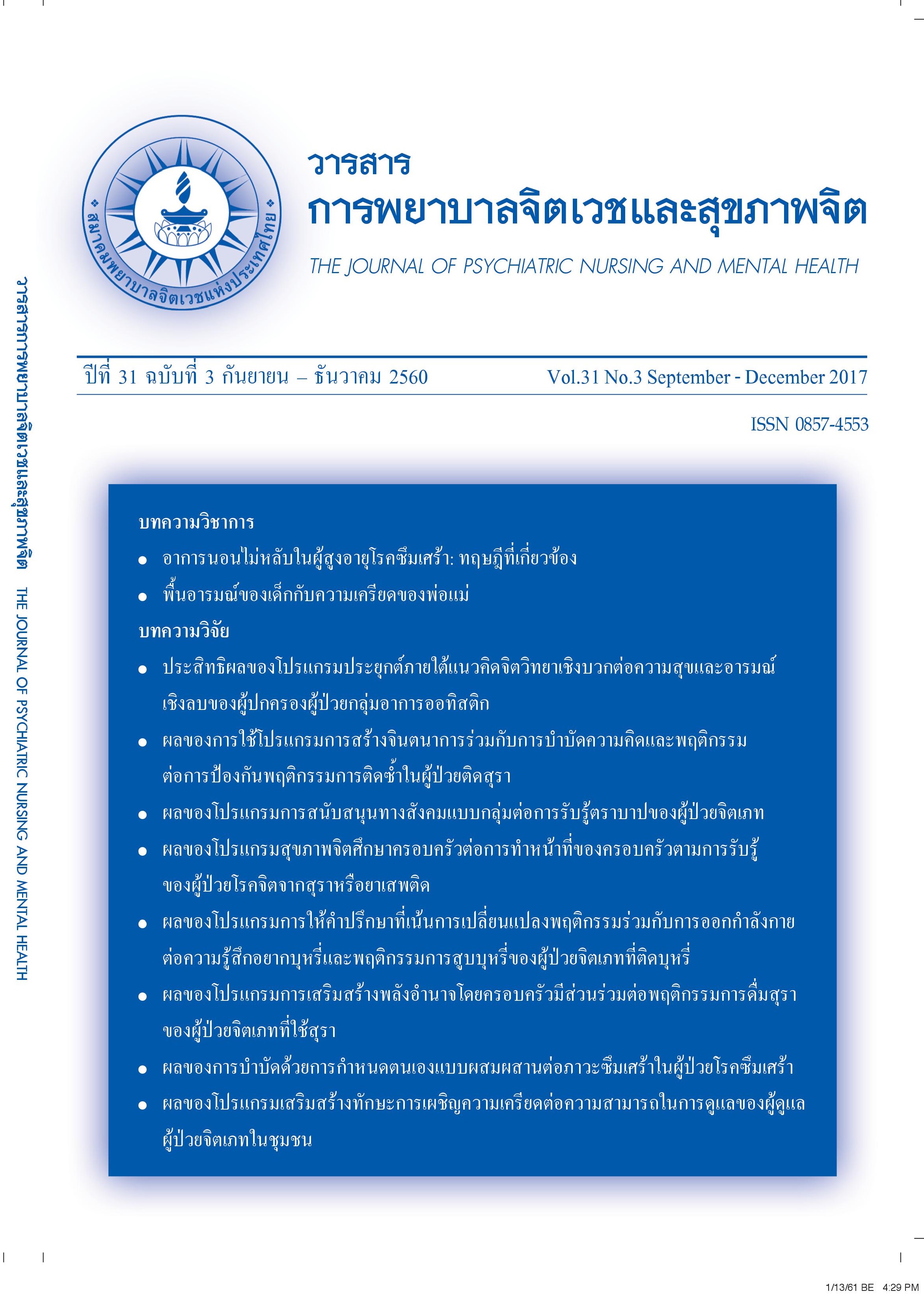ผลของการบำบัดด้วยการกำหนดตนเองแบบผสมผสาน ต่อภาวะซึมเศร้าในผู้ป่วยโรคซึมเศร้า THE EFFECT OF THE INTEGRATED SELF-DETERMINATION INTERVENTION ON DEPRESSION AMONG PATIENTS WITH MAJOR DEPRESSIVE DISORDER
Main Article Content
บทคัดย่อ
Abstract
Objectives: 1) to compare depression of patients with major depressive disorder before and after receiving the integrated self-determination intervention and 2) to compare depression of patients with major depressive disorder who received the integrated self-determination intervention and those who received regular nursing intervention.
Methods: This quasi-experimental, two groups pretest-posttest design was employed. Samples included thirty-six patients with major depressive disorder, aged 20-59 years old, both male and female who were treated at a psychiatric unit, out-patient department in a general hospital. The potential samples who met the inclusion criteria were selected and divided into two groups. The experimental group received the integrated self determination intervention with motivational interviewing technique and cognitive restructuring technique, whereas the control group received regular nursing intervention. The research instruments consisted of Beck Depressive Inventory-II (Thai version) and the Treatment Motivation Questionnaire (Thai version). All instruments were validated for content validity by five experts. The content validity index in Treatment Motivation Questionnaire was .96. The reliability of both instruments were .82 and .80 respectively. Data were analysis by using t-test.
Results: 1) Mean depression score of patients with major depressive disorder after receiving the integrated intervention was lower than that before (t = 11.783, p < .05). 2) Mean depression score of patients with major depressive disorder after receiving the integrated intervention was lower than that of the group who received the regular nursing intervention (t = 9.532, p < .05).
บทคัดย่อ
วัตถุประสงค์: 1. เพื่อเปรียบเทียบภาวะซึมเศร้าของผู้ป่วยโรคซึมเศร้าก่อนและหลังได้รับการบำบัดด้วยการกำหนดตนเองแบบผสมผสาน 2. เพื่อเปรียบเทียบภาวะซึมเศร้าของผู้ป่วยโรคซึมเศร้าที่เข้าร่วมการบำบัดด้วยการกำหนดตนเองแบบผสมผสานกับผู้ป่วยโรคซึมเศร้าที่ได้รับการพยาบาลตามปกติ
วิธีการศึกษา: การวิจัยครั้งนี้เป็นการวิจัยกึ่งทดลองแบบสองกลุ่ม วัดก่อน-หลัง กลุ่มตัวอย่างเป็นผู้ป่วยโรคซึมเศร้า จำนวน 36 คน อายุระหว่าง20-59 ปี ทั้งเพศชายและเพศหญิง ที่เข้ารับการรักษาในคลินิกจิตเวชแผนกผู้ป่วยนอกของโรงพยาบาลทั่วไปแห่งหนึ่งที่ผ่านเกณฑ์คัดเข้าตามคุณสมบัติโดยกลุ่มตัวอย่างได้รับการจัดเข้ากลุ่มสองกลุ่มกลุ่มทดลองเป็นกลุ่มที่ได้รับการบำบัดด้วยการกำหนดตนเองแบบผสมสานร่วมกับเทคนิคการเสริมสร้างแรงจูงใจและเทคนิคการปรับกระบวนความคิด และกลุ่มควบคุมเป็นกลุ่มที่ได้รับการพยาบาลตามปกติ เครื่องมือที่ใช้ในการวิจัยคือ แบบประเมินภาวะซึมเศร้าของเบค ฉบับภาษาไทยและแบบประเมินแรงจูงใจในการรักษา ฉบับภาษาไทย ซึ่งผ่านการตรวจสอบความตรงเชิงเนื้อหาโดยผู้ทรงคุณวุฒิทั้ง 5 ท่าน มีค่าความตรงเชิงเนื้อหาของแบบประเมินแรงจูงใจในการรักษาเท่ากับ .96 มีค่าความเที่ยงของทั้งสองเครื่องมือเท่ากับ .82 และ .80 ตามลำดับ วิเคราะห์ข้อมูลโดยใช้สถิติทดสอบที
ผลการศึกษา: 1. คะแนนเฉลี่ยภาวะซึมเศร้าของผู้ป่วยโรคซึมเศร้าหลังได้รับการบำบัดด้วยการกำหนดตนเองแบบผสมผสานต่ำกว่าก่อนได้รับการบำบัดด้วยการกำหนดตนเองแบบผสมผสานอย่างมีนัยสำคัญทางสถิติที่ระดับ .05 (t = 11.783)
2. คะแนนเฉลี่ยภาวะซึมเศร้าของผู้ป่วยโรคซึมเศร้ากลุ่มที่ได้รับการบำบัดด้วยการกำหนดตนเองแบบผสมผสานต่ำกว่ากลุ่มที่ได้รับการพยาบาลตามปกติอย่างมีนัยสำคัญทางสถิติที่ระดับ .05 (t = 9.532)
Article Details
บทความที่ได้รับการตีพิมพ์แล้ว เป็นลิขสิทธิ์ของสมาคมพยาบาลจิตเวชแห่งประเทศไทย
References
ธรณินทร์ กองสุข, สุวรรณา อรุณพงศ์ไพศาล, วชิระ เพ็งจันทร์, เกสราภรณ์ เคนบุปผา, รุ้งมณี ยิ่งยืน, พันธุ์นภา กิตติรัตนไพบูลย์ และ คณะ. (2554). ความชุกของโรคซึมเศร้า: การสำรวจระบาดวิทยาระดับชาติ ปี 2551. รายงานการประชุมวิชาการบูรณาการงานสุขภาพจิตแห่งประเทศไทย ครั้งที่ 2. กรมสุขภาพจิต.
บุญใจ ศรีสถิตย์นรากูล. (2553). ระเบียบวิธีการวิจัยทางพยาบาลศาสตร์. (พิมพ์ครั้งที่ 5). กรุงเทพมหานคร: ยู แอนไอ อินเตอร์มีเดีย.
พัชชราวลัย กนกจรรยา. (2554). ผลของโปรแกรมการบำบัดผสมผสานแบบสั้นโดยใช้การเสริมสร้างแรงจูงใจ ร่วมกับการปรับเปลี่ยน ความคิดและพฤติกรรมต่อภาวะซึมเศร้าและพฤติกรรมการเสพสุราในผู้เสพติดสุรา. วิทยานิพนธ์ปริญญาพยาบาลศาสตรมหาบัณฑิต สาขาวิชาสุขภาพจิตและจิตเวช, คณะพยาบาลศาสตร์, จุฬาลงกรณ์มหาวิทยาลัย.
พีรพนธ์ ลือบุญธวัชชัย, นันทิกา ทวิชาชาติ, และสมรัตน์ เลิศมหาฤทธิ์. (2551). ความสัมพันธ์ระหว่างปัญหาสัมพันธภาพระหว่างบุคคล กับโรคซึมเศร้าในผู้ป่วยโรคซึมเศร้าไทย: การศึกษาโดยมีกลุ่มควบคุมแบบจับคู่. วารสารสมาคมจิตแพทย์แห่งประเทศไทย, 57(1): 69-80.
มาโนช หล่อตระกูล และปราโมทย์ สุคนิชย์. (2558). จิตเวชศาสตร์รามาธิบดี Using DSM-5. (พิมพ์ครั้งที่ 1).กรุงเทพฯ: มหาวิทยาลัย มหิดล.
ลัดดา แสนสีหา. (2536). ความซึมเศร้าและความคิดอัตโนมัติในทางลบของวัยรุ่นตอนปลาย. วิทยานิพนธ์พยาบาลศาสตรมหาบัณฑิต สาขาวิชาสุขภาพจิตและการพยาบาลจิตเวช, คณะพยาบาลศาสตร์. มหาวิทยาลัยเชียงใหม่.
วนิดา พันธ์สุรินทร์. (2556). ผลของโปรแกรมแบบบูรณาการที่เน้นแนวคิดการบำบัดทางความคิดพฤติกรรมต่อภาวะซึมเศร้าในผู้ป่วย โรคซึมเศร้า. วิทยานิพนธ์ปริญญาพยาบาลศาสตรมหาบัณฑิต สาขาวิชาสุขภาพจิตและจิตเวช, คณะพยาบาลศาสตร์, จุฬาลงกรณ์ มหาวิทยาลัย.
อรพรรณ ลือบุญธวัชชัย และพีรพนธ์ ลือบุญธวัชชัย. (2553). การบำบัดรักษาทางจิตสังคมสำหรับโรคซึมเศร้า. (พิมพ์ครั้งที่ 1). กรุงเทพฯ: ธนาเพรส จำกัด.
Arkowitz, H., Westra, H. A., Miller, W. R., & Rollnick., S. (2008). Motivational Interviewing in the Treatment of Psychological Problem. New York: Guilford Press.
Baker, A., Lee, N. K., Claire, M., Lewin, T. J., Grant, T., Pohman, S., et al. (2005). Brief cognitive behavioral interventions for regular amphetamine users: a step in the right direction. Addiction, 100(3), 367-378.
Barch, D. M., Yodkovik, N., Sypher – Locke, H., & Hanewinkel, M. (2008). Intrinsic motivation in schizophrenia: Relationships to cognitive function, depression, anxiety, and personality. Journal of Abnormal Psychology, 117(4), 776-787.
Beck, A. T., & Alford, B. A. (2009). Depression: Clinical, experimental, and theoretical aspects. (2nd ed.). Pennsylvania: University of Pennsylvania Press.
Beck, A.T. (1967). Depression: Clinical, Experimental, and theoretical aspects. New York: Harper Row.
Beck, A.T. (1979). The diagnosis and management of depression. Philadelphia: University of Pennsylvania Press.
Beker, J. (1974). Depression: Theory and research. Washington DC: V.H. Winston& Sons Inc.
Britton, P. C., Patrick, H., Wenzel, A., & Williams, G. C. (2011). Integrating motivational interviewing and Self- Determination Theory with Cognitive Behavioral Therapy to prevent suicide. Cognitive and Behavioral Practice, 18, 16-27.
Colman, I., Naicker, K., Zeng, Y., Ataullahjan, A., & Senthilselvan, A. (2011). Predictors of longterm prognosis of depression. Canadian Medical Association, 17, 1969-1976.
Deci, E. L., & Ryan, R. M. (1985). Intrinsic motivation and self - determination in human behavior. New York: Plenum.
Deci, E. L., & Ryan, R. M. (2008). Self-determination theory: A macrotheory of human motivation, development, and health. Canadian Psychology, 49(3), 182-185.
Judd, L. L., Paulus, M. J., Schettler, P. J., Akiskal, H. S., Endicott, J., Leon, A. C., et al. (2000). Does incomplete recovery from first lifetime major depressive episode herald a chronic course of illness? American Journal Psychiatry, 157(9), 1501-1504.
Miller, W. R., & Rollnick, S. (2002). Motivation interviewing. New York: Guilford Press.
Ryan, R. M., Plant, R.W., & O’Malley, S. (1995). Initial motivations for alcohol treatments: relations with patient characteristics, treatment involvement and dropout. Addictive Behaviours, 20(3), 279–297.
Sadock, B. J., & Sadock, V. A. (2005). In: Kaplan & Sadock’s Comprehensive. Textbook of Psychiatry. (8th ed.). U.S.A.: Lippincott Williams and Wikins.
Selingman, M. (1991). Helplessness: On depression, development and death. (Second edition.). New York, USA: W.H. Freeman and Company.
Sheet, E. S., & Craighead, W. E., (2014). Comparing chronic interpersonal and non-interpersonal stress domains as predictors of depression recurrence in emerging adults. Behavior Research and Therapy, 63, 36-42.
Stoudemire, A., Frank, R., Hedemark, N., Kamlet, M., & Blazer, D. (1986). The economic burden of depression. General Hospital Psychiatry, 8(6), 387-394.
Treadway, M. T., Bossaller, N., Shelton, R. C., & Zald, D. H. (2012). Effort-Based Decision-Making in Major Depressive Disorder: A Translational Model of Motivational Anhedonia. Journal of Abnormal Psychology, 121(3), 553-558.
Westra, H. (2004). Managing resistance in cognitive behavioral therapy: The application of motivational interviewing in mixed anxiety and depression. Cognitive Behavior Therapy, 33(4), 161-175.
World Health Organization. (2012). Depression. Retrieved June 13, 2016 .from http:// www.who.int/mental_health/management/depression/wfmh_paper_depression_wmhd_2012.pdf.

